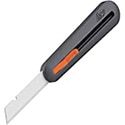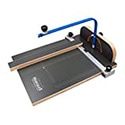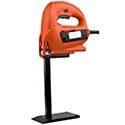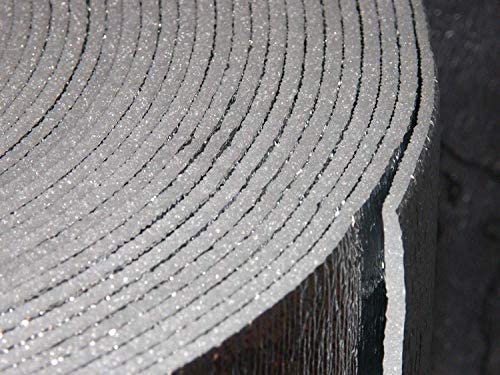Best Way to Cut Foam Board – Which Tool to Use? – Reviews & Buyer’s Guide
-

- Last updated:


Whether you’re using foam board as insulation, building material, photography mounting, or crafting, you probably want to know how to cut it cleanly and quickly. You want to get through the foam with ease, but you also don’t want to leave a ragged edge, and you definitely don’t want to create toxic fumes in the process.
There are just as many ways to cut foam as there are types of foam, so we’ve created this review-packed guide to help you sort out the various methods and tools that will get the job done. We’ve also recommended the top products available on the market to kick out the guesswork and help you cut faster. Read on to learn about our top 5 picks to help you decide where to start.

Comparison of our Favorite Picks for 2025
| Rating | Image | Product | Details | |
|---|---|---|---|---|
Best Overall Method
 |

|
Slice 10559 3″ Extra Long Industrial Knife |
|
CHECK PRICE |

|

|
RoMech Foam Cutter – Pro Electric Hot Knife (200W) |
|
CHECK PRICE |

|

|
X-Acto X5282 Basic Knife Set |
|
CHECK PRICE |
|
|

|
Hercules Tabletop Styrofoam Hot Wire Cutter (CT-115) |
|
CHECK PRICE |
|
|

|
Acu-Cutter 350 Foam Saw w/ 8" Blade |
|
CHECK PRICE |
The 5 Best Tools for Cutting Foam Board
1. Long Bladed Utility Knife – Best Overall Method
A utility knife with a long blade is our top pick. You can use it for most types of foam, including for crafting or foam board insulation. Make sure you choose a smooth blade, though (not serrated), to avoid ragged edges. Meanwhile, you’ll want to apply weight to the foam board to keep it from sliding and cut in one smooth motion at about a 45-degree angle. If you start sawing into the board, you’ll have ugly edges and little foam shreds flying everywhere.
Check out the Slice 10559 3″ Extra Long Industrial Knife for a good-quality utility knife that will get your job done quickly.
- Slice safety blades' unique cutting edge might seem dull, but it cuts right through your material while keeping you safe! Slice blades...
- Safe and effective sharpness and stay there 11 times longer than steel.
- 4 Preset Cutting depths, handle a variety of materials. Extra long tool stops are specially designed for cutting foam, batting,...
- Smooth blade
- Adjustable cutting depth
- Easy change blade
- Versatile for different thicknesses of foam
- Economical
- Requires some manual strength/grip
- Knife not ideal for harder surfaces
2. Hot Knife
When a standard knife won’t cut it, you might need some power. A hot knife can give you power and freedom of movement, making it our second pick. Like the long-blade utility knife, it’s also great for varying thicknesses of foam. It’s also recommended for cutting stiffer PVC foam board, and it’s great for Styrofoam since it will leave you with virtually no mess.
As with any heating element against foam, check the manufacturer’s recommendations, as some foam types can emit toxic chemicals. If that is the case, you can always wear a mask and goggles before cutting.
Check out our top pick, the RoMech Foam Cutter – Pro Electric Hot Knife (200W). It will get you cutting through foam with ease.
- ✅【CLEAN AND SMOOTH CUT, NO MESS】RoMech hot knives cut the styrofoam smooth and fast like butter, seal the edges clean, and leave...
- ✅【ADJUSTABLE POWER 】The heat power can be approximately controlled by using the temperature control dial on the handle. Fifteen...
- ✅【INDUSTRIAL GRADE 】Suitable for commercial and industrial use, it can cut lightweight foam, KT board pink foam, polyurethane,...
- Mess-free
- Easy to handle
- Heavy duty for personal or industrial use
- Need a handy power source where you’re cutting
3. X-Acto Knife
While this method will serve you best for thinner foam boards, such as those used for crafts or photo-backing, the dexterity and control you’ll get from an X-Acto knife make it one of our top picks. Since it’s lightweight, super sharp, and easy to hold like a pencil, the X-Acto knife produces dynamic shapes, curved cuts, and great detail.
On the downside, you won’t want to rely on one for thicker foam, especially the foam board used in construction. The effort and pressure you’ll need will give you a headache. Stick with an X-Acto for foam thicknesses less than 1 inch. As with the long-blade utility knife, you’ll want to cut smoothly without sawing to keep your edges clean.
Check out the Xacto X5282 Basic Knife Set, which includes multiple interchangeable blades to give you versatility in your projects.
- Elmer's inspires people to create
- Trusted
- Craft
- Interchangeable blades
- Top crafting knife on the market
- Excellent sharpness
- Economical
- Poor performance on thicker foam
- Container isn’t great
4. Hot Wire Cutter
Cutting thick foam can be a big job, but it’s nothing a hot wire cutter can’t handle. Designed to slide effortlessly through the foam and leave perfect edges, these cutters can provide diversity in how you cut. They’re great for crafts and intricate cutting, as well. While you’ll need to use extra caution with fumes (check the foam manufacturer for recommendations on heating it) and be careful with the heat, you can save yourself a lot of effort by using this method.
They come in different styles, too. The first is a tabletop model with a square and measuring ticks (which we recommend), and the second is a handheld device with either a wand style or an arc. For ease of use, a tabletop device is perfect.
Check out our top pick below, the Hercules Tabletop Styrofoam Hot Wire Cutter (CT-115):
- 💪 The Hercules CT-115 Hot Wire Foam Cutting Table heats up quickly; the wire can reach its maximum operating temperature of 570°F...
- 💪 The Hercules CT-115 cuts quickly and smoothly; it seals the edges clean without leaving debris.
- 💪 Easily cuts shapes like cylinders, cones, tapers, cubes and polygons by simply adjusting the angle of the wire.
- Heats quickly
- Variation of shapes
- Good stability
- Good midrange price point
- Not good for big sheets.
- Not for industrial use
5. Foam Cutting Saw
On the opposite side of the spectrum from the X-Acto knife is a foam-cutting saw. If you need to cut large amounts of thick foam, an electric foam saw will spare you countless hours of manual labor and grip fatigue. It’s designed with a foot to stabilize the tool against the foam and a serrated, quick-moving blade, and it will plow through foam like butter.
You’ll also end up with smooth edges because of the quick, powered blade movement. On the downside, it could leave a mess of foam particles in your work area. The foam-cutting saw is also on the higher end of the price spectrum.
Check out our top pick below for the best electric foam saw of the year, the Acu-Cutter 350 Foam Saw w/ 8″ Blade
- Volts: 120 AC, Amps: 4.5
- Variable Speed, 0-3200 RPM
- Includes 8" blade (1 stationary, 1 reciprocating) and base
- Great for thick foam
- Perfect for large projects
- Works for textile foam
- Contact company for blade replacement
- High price point
See Also:
- BEST WAY TO CUT CEMENT BOARD – WHICH TOOL TO USE? – REVIEWS & TOP PICKS
- BEST WAY TO CUT METAL ROOFING – WHICH TOOL TO USE? – REVIEWS & TOP PICKS
- WHAT’S THE BEST WAY TO CUT PVC PIPES – WHICH TOOL TO USE? – REVIEWS & BUYER’S GUIDE
Buyer’s Guide
Types of Foam
While some types of foam can be used for multiple projects, others are for more specific uses. Knowing which type you need can help you narrow down what you need before cutting.
- Future foam: If you are looking for a high-quality, inexpensive foam that is great for upholstery, making small crafts, or even creating detailed puppets, future foam is perfect.
- Foam board: Made of expanded polystyrene, this foam is best for crafts, exhibits, and school projects when a harder foam is better.
- Ampex R-11: This is commonly known as “egg crate” foam and is perfect for soundproofing, like in a music studio or a shooting range.
- Melamine: Used for insulation.
- Open cell: This is often used as a protection pad when breakable items are stored or shipped. It’s also used in gun cases.
- Closed cell: Using closed cells is a very quick and easy way to insulate a home, and they can be sprayed through a special applicator apparatus. Once it sets, it expands and hardens.
There are several other types, but most are extensions or permutations of the types above, especially as they apply as insulators.
Cutting Your Foam
You have the project planned out. You know what foam you are going to use. Now it’s time to cut it, and there are several tools you can use. Some foam can be easily sliced with a sharp blade, and others are better suited to be cut with a hot wire. It all depends on the nature of the project.
- A long blade or scissors will work for crafting, homework, making a diorama, or building a dollhouse.
- If you’re cutting insulation, a denser drywall knife is better.
- For big projects working with open cell foam, using a hot knife will not only cut through it quickly and in a clean line but also seal up the cells and eliminate the extra mess that occurs when cutting open cell foam with a blade.
Practice Safety When Cutting Foam Boards
Always wear personal protective equipment when cutting foam boards to ensure chunks of the foam don’t end up hurting you or others. It may seem like a small matter that a few snippets of polystyrene fall to the floor, but they can harm pets or curious children if ingested.
Put away sharp cutting instruments and unplug all electric cutting devices. You never know who might find it and make a foolish mistake.
RELATED READING:
- What’s our preferred way to cut plaster?
- Which tool do we recommend you use for cutting metal roofing?

Conclusion
We hope these product reviews have helped you decide on the best tool and method for your needs. Depending on its thickness, the long-bladed utility knife is the best tool for cutting foam. Remember to keep it simple for the best results. If your job is a big one, use a hot blade or hot wire cutter. If you’re crafting or using thin sheets, go for small and sharp knives or X-Acto blades. Smooth strokes will get you clean cuts, and you’ll want to avoid serration unless you want to clean up the mess afterward. We wish you luck finding the perfect product. Now, grab a tool and tackle that foam!
Contents







